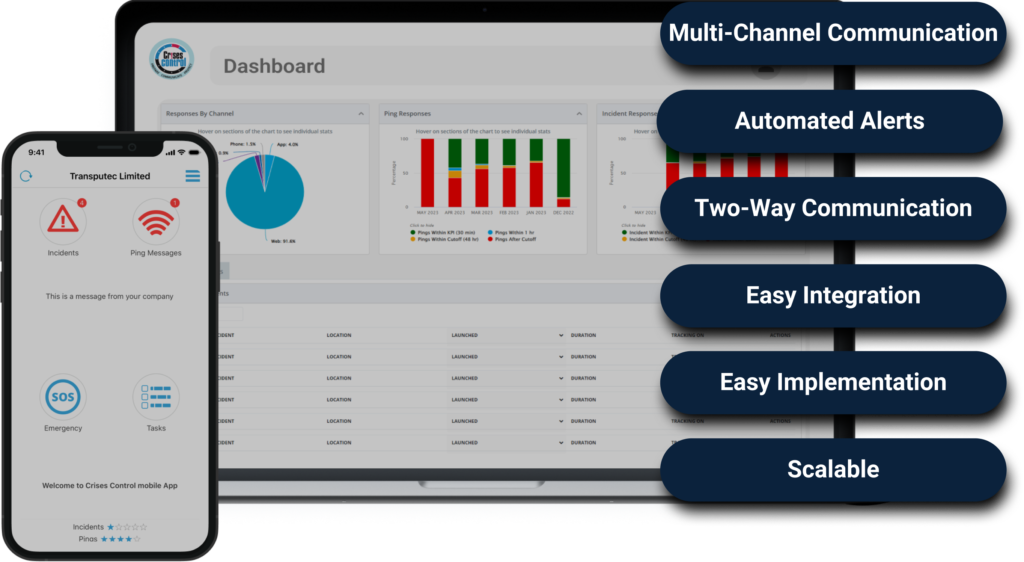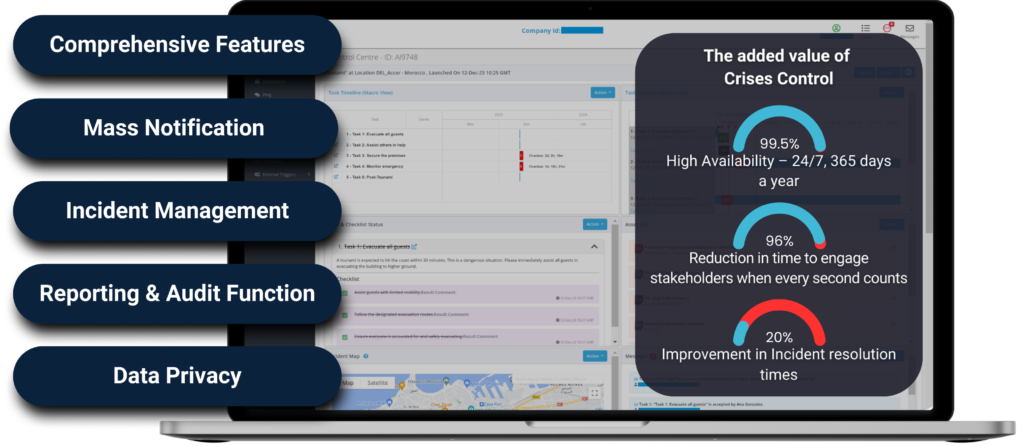Written by Anneri Fourie | Marketing Executive
In an increasingly unpredictable world, businesses face a variety of challenges, ranging from natural disasters to cyberattacks. As a business leader, ensuring that your organisation is prepared to handle crises efficiently and effectively is paramount. This is where emergency communication systems come into play. By leveraging these systems, businesses can significantly enhance their resilience and crisis preparedness.
In this blog, we’ll explore how emergency communication systems can benefit your business and how Crises Control can help you achieve unparalleled readiness.
Understanding Emergency Communication Systems
Emergency communication systems are designed to disseminate information quickly and accurately during a crisis. These systems ensure that all stakeholders, including employees, customers, and partners, receive timely updates and instructions, thereby minimising confusion and potential harm. At their core, these systems serve as the backbone of an organisation’s crisis management strategy, providing the necessary tools to coordinate responses, track incidents, and manage resources efficiently.
The Role of Emergency Mass Notification
A critical component of emergency communication systems is the emergency mass notification system. This system enables businesses to send alerts to a large audience within seconds, ensuring that critical information reaches everyone who needs it, regardless of their location. By utilising various channels such as SMS, email, voice calls, and push notifications, emergency mass notification systems ensure redundancy and maximise the likelihood that messages are received promptly.
Key Features of Effective Emergency Communication Systems

-
- Multi-Channel Communication: Effective systems use multiple communication channels to ensure message delivery even if one channel fails. This redundancy is crucial for reaching all stakeholders in a timely manner.
-
- Automated Alerts: Automation helps in sending predefined alerts based on specific triggers, reducing the time taken to inform stakeholders during the initial moments of a crisis.
-
- Two-Way Communication: Modern systems facilitate two-way communication, allowing stakeholders to provide feedback or confirm receipt of messages. This interaction is vital for understanding the situation on the ground.
-
- Integration with Other Systems: Integration with other business systems, such as HR databases and IT infrastructure, ensures that contact information is up-to-date and that the communication system can leverage other business data for more efficient crisis management.
-
- Scalability: As businesses grow, their communication needs evolve. Scalable systems can accommodate increasing numbers of users and more complex communication requirements without compromising performance.
Enhancing Business Resilience with Emergency Communication Systems
Immediate Response and Coordination
During a crisis, every second counts. Emergency communication systems enable immediate response by ensuring that all relevant parties are informed instantly. This rapid dissemination of information allows for quick coordination and mobilisation of resources, which is critical in mitigating the impact of the crisis. For example, in the event of a fire, an emergency communication system can alert all employees, direct them to the safest exits, and provide real-time updates on the situation.
Continuity of Operations
Business continuity is a major concern during crises. By maintaining clear and consistent communication, businesses can ensure that critical operations continue with minimal disruption. Emergency communication systems facilitate this by providing a platform for ongoing updates, instructions, and collaboration. This continuous flow of information helps maintain order and ensures that everyone knows their roles and responsibilities during the crisis.
Protecting Stakeholders
The safety and well-being of employees, customers, and partners are paramount during any crisis. Emergency communication systems play a crucial role in protecting these stakeholders by providing timely alerts and instructions. For instance, in the case of a severe weather event, an emergency mass notification system can warn employees to stay indoors or evacuate as necessary, thereby reducing the risk of injury.
How Crises Control’s Emergency Communication System Can Help

Crises Control stands out as an award-winning provider of advanced emergency communication solutions tailored to meet the unique needs of businesses. Here’s how our system can enhance your business resilience and crisis preparedness:
Comprehensive Communication Tools
Crises Control offers a suite of communication tools that ensure messages are delivered through multiple channels. Whether it’s SMS, email, push notifications, or voice calls, our system guarantees that critical information reaches all stakeholders promptly. This multi-channel approach ensures that even if one method fails, others are available to keep the lines of communication open.
Automated and Manual Alerts
Our platform supports both automated and manual alerting capabilities. Automated alerts can be pre-configured to trigger based on specific criteria, ensuring immediate notification without human intervention. Manual alerts allow for custom messages to be sent as situations evolve, providing flexibility in communication.
Real-Time Incident Management
Crises Control’s system includes a robust incident management feature that allows for real-time tracking and coordination. This feature enables businesses to manage resources efficiently, monitor the progress of the crisis response, and make informed decisions based on up-to-date information.
Two-Way Communication
Our system supports two-way communication, allowing stakeholders to respond to alerts, confirm receipt, and provide status updates. This feedback loop is essential for understanding the situation on the ground and making necessary adjustments to the response strategy.
Integration and Scalability
Crises Control seamlessly integrates with existing business systems, ensuring that contact information is always current and that the communication system can leverage other business data. Additionally, our platform is scalable, accommodating the needs of businesses as they grow and their communication requirements become more complex.
User-Friendly Interface
Ease of use is a hallmark of Crises Control’s system. The user-friendly interface ensures that both administrators and users can operate the system effectively, even under the stress of a crisis. This intuitive design reduces the learning curve and enhances overall efficiency.
Reporting and Audit
Crises Control’s incident reporting and audit tools offer comprehensive tracking and documentation of all crisis-related activities. This feature is crucial for post-incident analysis, regulatory compliance, and continuous improvement of crisis management strategies. By providing detailed reports and audit trails, businesses can review their response actions, identify areas for improvement, and ensure accountability.
Proven Metrics of Crises Control
Crises Control’s effectiveness is evidenced by several key metrics:
-
- Trigger Alerts 96% Faster: Our integration with monitoring systems, such as fire alarms or IT ticketing systems, improves alert-to-response times by 96% compared to traditional call tree methods.
-
- 96% Reduction in Time to Engage Stakeholders: When every second counts, our system reduces the time to engage stakeholders by 96%.
-
- 20% Improvement in Incident Resolution Times: Our streamlined communication and incident management processes lead to a 20% improvement in resolving incidents.
-
- 99.5% High Availability: Crises Control ensures your communication system is available 24/7, 365 days a year, with a high availability rate of 99.5%.
-
- For more insights into the ROI of using Crises Control, you can check out our detailed ROI blog.
Learn How Crises Control Benefits Your ROI
Conclusion: Strengthen Your Crisis Preparedness Today
In today’s volatile environment, having a robust emergency communication system is not just a good practice—it’s a necessity. Crises Control offers comprehensive, reliable, and scalable solutions to help your business manage crises effectively, ensuring the safety of your stakeholders and the continuity of your operations.
Don’t wait for a crisis to strike. Enhance your business resilience and crisis preparedness with Crises Control’s emergency communication system. Contact us today to get a free personalised demo and see how our solutions can safeguard your organisation.
Request a FREE Demo









